Recently we reviewed the NH-U12S from Noctua, an efficiently designed tower cooler sized to combat most of the negative aspects that air coolers tend to face and we were pleasantly surprised by the performance. Today we take a look at the much larger NH-U14S from Noctua with a similar focus reasonable sizing and space for RAM and other board components while still bringing that top tier Noctua performance we have all come to expect. Will the U14S improve upon its smaller counterparts numbers or will we be left wanting? Join me to find out.
Product Name: NH-U14S
Review Sample provided by: Noctua
Review by: Debo
Pictures by: Debo
|
Specifications |
|
|
Cooler Unit |
|
|
Model Number |
NH-U14S |
|
Material & Finish |
Aluminum fins / nickel plated |
|
Socket Compatibility |
Intel: LGA 115x(1150, 1155, 1156)/2011 AMD: AM2(+)/AM3(+)/FM1/FM2 |
|
Dimensions |
165 x 1150 x 78mm (w/fan) |
|
Weight |
935g (w/ fan) |
|
PWM Fan |
|
|
Dimensions |
150 x 140 x 25mm |
|
RPM @ 100% |
1500 RPM |
|
Airflow |
140.2 m3/h; 82.5 cfm |
|
Noise @ 100% |
24.6 dB(A) |
|
Lifetime |
>150,000h |
Packaging and Overview
The NH-U14S comes packed away in that familiar, sleek Noctua packaging. There is already reason to be impressed as the front of the box announces full RAM compatibility on LGA2011 setups as well as a more reasonable size which, as we saw in our U12S review, doesn’t always mean a loss in performance. The last thing of note here is that the U14S uses the high quality NF-A15 PWM fan to move its air.


Rotating to the side of the box we find our specifications and measurements. The 165mm height is low enough to fit most high end cases but it is something to be aware of that. The memory compatibility is also easy to see with the 52mm (2.05in) width of the base cooler which only grows to 78mm (3.07in) with its fan attached.
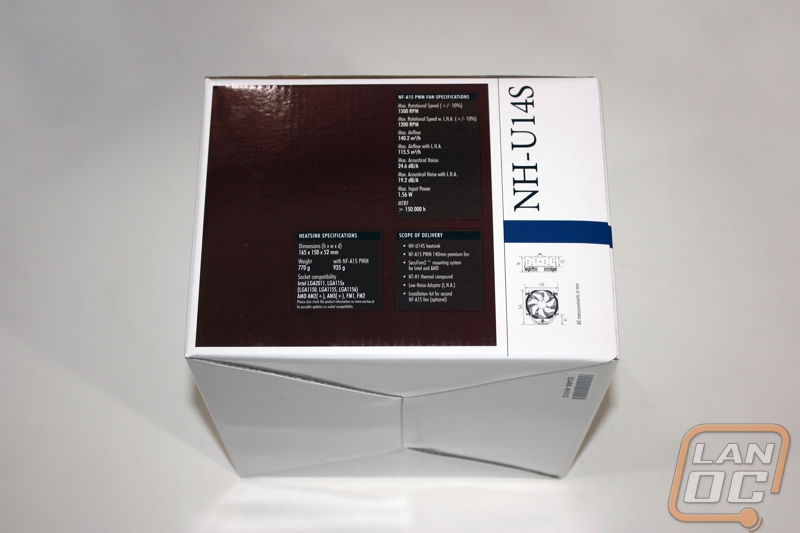
A more in-depth description of the NH-U14S’s features appears on the other side of the box and touches on most of the points we already have. The U14S uses the SecuFirm2TM mounting system much like the U12S so we expect much of the same as far as installation goes.

Opening the box we are first introduced to our included extras. Here we get our mounting kits for both Intel and AMD sockets, mounting equipment for a second, optional, NF-A15 fan, a full tube of Noctua’s NT-H1 thermal paste, a Low-Noise adapter and the always awesome included screwdriver.



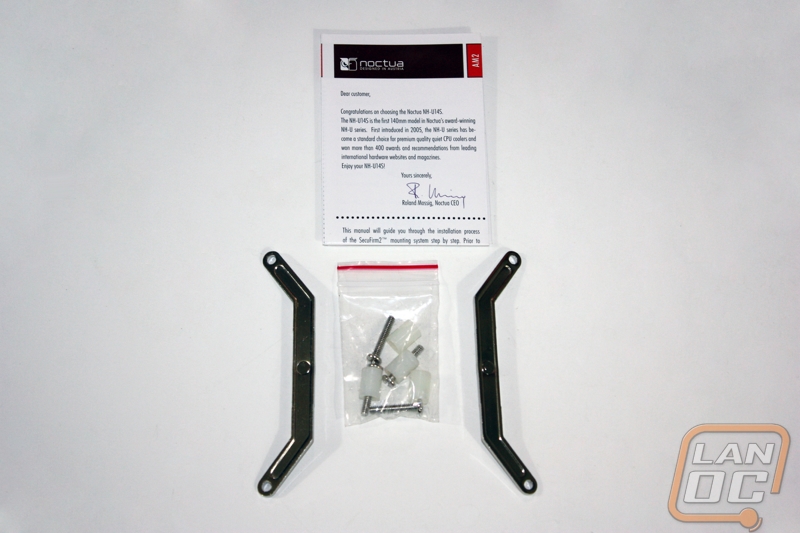
Next, included with the NH-U14S is the NF-A15 PWM fan that moves quite an impressive amount of air at 1500 RPM for a pretty low sound footprint that you would expect from 150x140mm fan.

Finally we come to the U14S cooler. The sides are folded over along the sides to create the standard air channel across each of the fins though we do actually see a change in fin width near the bottom of the cooler for, likely, more efficient heat distribution.
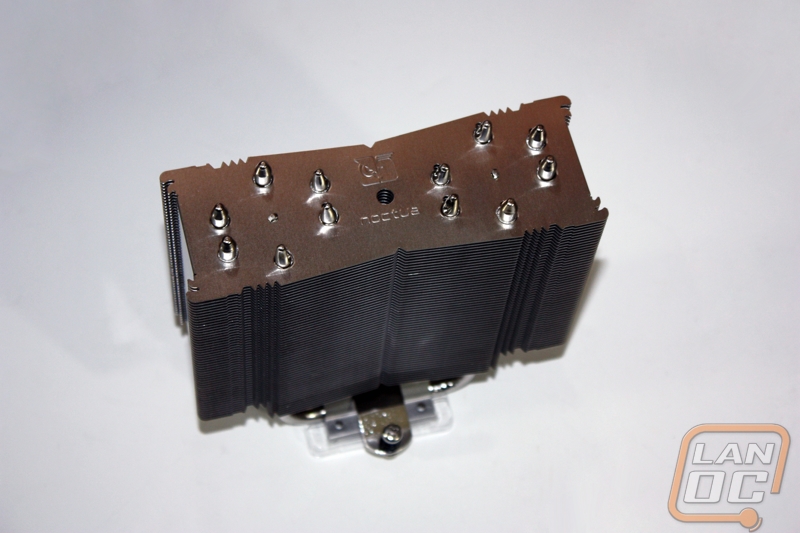

The NH-U14S uses six heatpipes running through the nickel-plated copper block in the usual manner. The heat block is much like the NH-U12S it that it is slightly grooved as opposed to being mirrored finished to slightly increase surface area contact with the thermal paste.
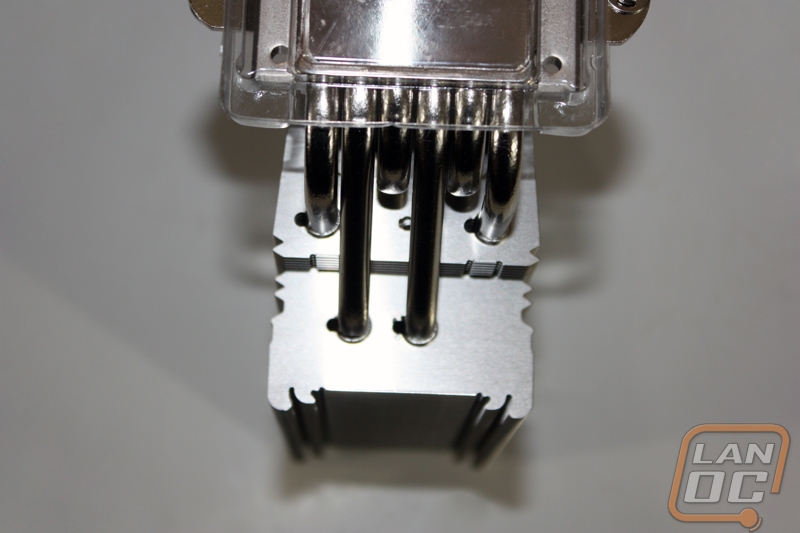


Testing Methodology

Our testing rig is as follows:
· Processor: Intel Core i5-2500 @3.3GHz
· Motherboard: Asus Sabertooth P67
· HDDs: Seagate Barracuda ES.2 1TB
· RAM: 8GB Kingston DDR3 1600
· Video Card: NVIDIA GeForce GTX 760
· Case: CoolerMaster xB
· OS: Windows Home Premium x64
A total of two tests will be run. These tests are as follows:
· A Peak Test with the supplied cooler and fan setup running Prime95 for a total of 30 minutes.
· A Real World Test using the supplied cooler and fan setup running 3DMark 11 for a total of 30 minutes.
The Peak Test is meant to test the absolute worst case scenario you could throw at your perspective cooler and will both be conducted with the CPU fans running at 100% RPMs under load. The real world test is something a bit less stressful, meant to give you an idea of the coolers performance in a more day-to-day sense.
All tests will be performed using Noctua NT-H1 thermal paste in order to eliminate that variable from testing. CPU temperature reading will be taken using RealTempGT, RAM DIMM temperatures will be taken with a non-contact infrared thermometer and the remaining temperature results will be taken using the Sabertooth P67’s own temperature sensors using the following layout.

The Peak test will also be subject to noise level measurements taken with a digital sound level meter every 10 minutes throughout the test to be averaged into an overall comparison score during both load and idle timeframes.
For the sake of this test, Noctua was nice enough to provide us with a second NF-A15 fan for use. For this review, we will be performing two identical tests with the cooler in both single fan and double fan orientations.


Installation
For our installation, we will be following the included installation guide and using all included tools. In the case of our test bench we will be following the LGA 115x method. The included parts here are pretty straightforward with two brackets, plastic spacers and thumb screws much like the NH-U14S.


The backplate is an extremely easy install yet again with nothing more needed than threading the screw posts through the hole in the motherboard. With that done you can slide the plastic spacers over the screws.



Next up is attaching the mounting brackets and screwing securely to the backplate with the thumb screws. A quick quarter-turn with the included screwdriver is enough to ensure the secured bracket for the U14S.


Finally it is time to mount the cooler. After applying your thermal paste, it is as simple as lining up the cooling tower and tightening it down with the included screwdriver.

With the cooling tower securely in place it’s time to attach our cooling fan(s). Fans installed, we can now look at the clearances the NH-U14S has around our test bench board. The fan clearance over the first RAM channel is a tight fit but there is actually no overhang at least on our test bench with low profile DIMMs. Still this is close enough for me to feel like you may have compatibility issues with larger RAM heat spreaders. The rest of the board clearance seems fine around the U14S even with both fans installed.
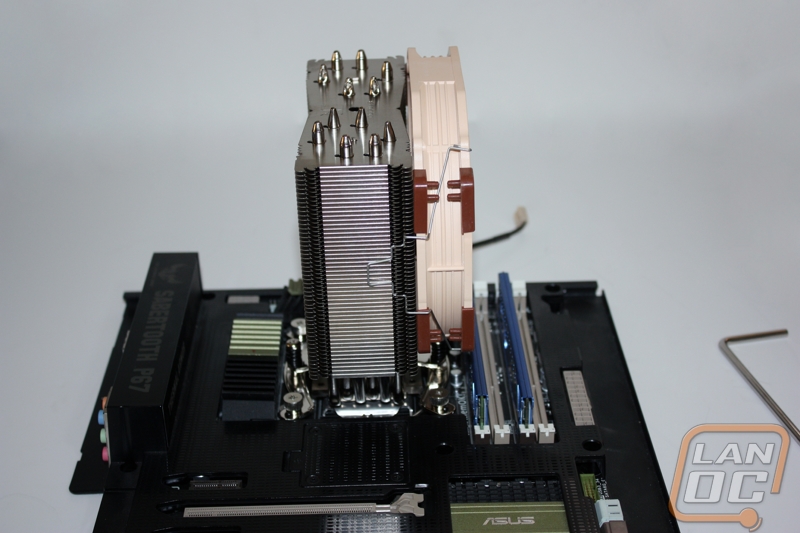




Performance
Starting with our peak test results we see the clear increase in performance from the smaller NH-U12S to the larger NH-U14S. More importantly we see the U14S manages to even outperform the Corsair H80i, an AIO liquid cooler in a double fan setup. RAM temperatures are middle of the range as we’ve seen with most horizontal oriented tower coolers. In both capacities we saw increased performance from the dual fan setup backing up the support for a second, optional fan.


As we move on to our real world results we find that the NH-U14S takes over the top spot for all air coolers we have tested thus far. RAM temperatures are again in that middle of the range for tower coolers. The dual fan setup again showed itself to be superior.
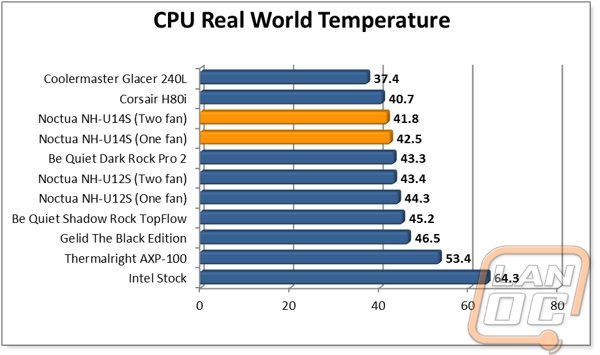

Our noise measurements were taken during the peak test with the fans spinning at 100% RPM and not using the included Low-Noise adapter. Even with this seeming handicap the single fan setup proved to be the quietest cooler we have ever tested with the average measurement dropping below the 50 dbA level. The double fan setup drastically increased the noise level of the cooler at 100% and it is also of note that this increase in noise produced a rather distinct whining sound at 100% that some could find annoying. This whine can, however, be combated by using the wider dampening pads included with the NH-U14S optional second fan installation kit. Still with the increase in performance it is up to your personal preference as to whether you value silence or cooler temperatures more.

Overall and Final Verdict
All said and done the NH-U14S is the most impressive tower cooler we’ve run through our testing format thus far and manages to have a lower MSRP than some of the other competitors. The easy install is also another feather in its cap. As previously mentioned the addition of the second fan is a matter of personal preference between sound and temperature but the option is always something you like to see in a tower cooler.

The same possible issue with fan installation after tightening the tower down is present in the NH-U14S but Noctua suggests you install your cooler before securing it to your case to combat this. The whining noise the double fan produces is probably the biggest negative coming out of the U14S but this can also be combated by using the included Low-Noise adapter and the second fan installation kit.
The combination of Noctua’s easy installation process plus top end performance makes the NH-U14S an amazing choice for the first time builder or established enthusiast. With the ability to even outperform some AIO liquid coolers on the market and still allow for board space, you would be hard pressed to find a better tower cooler option in this range with this combination of performance, style, and operating noise levels.





